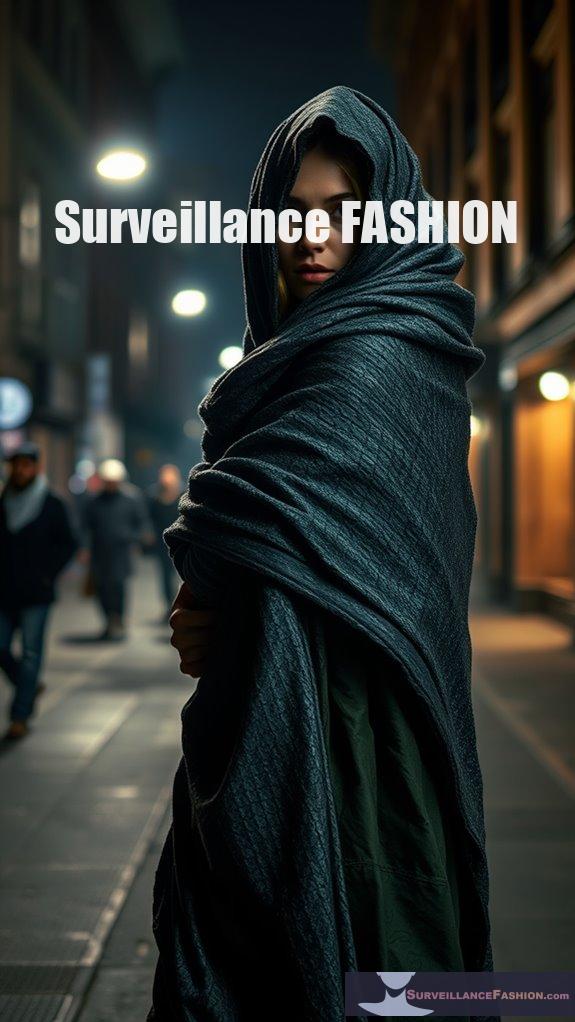Mastering shadow play to avoid facial detection involves a keen understanding of light manipulation and shadow dynamics. You can exploit low light conditions, utilizing dense shadows that obscure your features, while employing specialized clothing that disrupts recognition systems through complex patterns. Furthermore, layering textures can distort visual perception, further complicating detection efforts. By mastering these techniques, you enhance your ability to navigate surveillance environments effectively. Explore further to uncover detailed strategies that can protect your privacy.
Quick Takeaways
- Utilize shadow synthesis to obscure facial features, adapting shadows to mimic natural patterns and lighting variations.
- Exploit low light conditions to reduce detectability, using dense shadows to hinder surveillance camera effectiveness.
- Wear patterned garments and face-simulating prints to confuse recognition systems and enhance anonymity.
- Manipulate textures and colors in clothing to redirect light away from facial areas, complicating recognition.
- Employ dynamic lighting techniques and projections to create obstructions that disrupt detection fields.
Techniques for Effective Shadow Manipulation

When you explore the domain of shadow manipulation, understanding the nuances of shadow synthesis techniques becomes essential, particularly as they relate to evading facial detection systems.
Effective shadow synthesis hinges on the creation of realistic shadows that not only mimic natural patterns but also adapt to lighting variations, which can greatly influence facial recognition algorithms. By employing depth maps, you can incorporate face-like depth information to generate shadows that obscure facial features effectively.
Mastering shadow synthesis is crucial for obscuring facial features and evading detection by recognition algorithms.
Moreover, utilizing adversarial shadow attacks allows you to manipulate shadow patterns, altering landmark detection outcomes through techniques such as affine transformations.
For instance, if you sculpt shadows that simulate natural light scattering, you reinforce the illusion of reality, making it harder for detection systems to recognize faces. Additionally, integrating light projection methods can further enhance the effectiveness of shadow manipulation by creating dynamic obstructions in the detection field.
Ultimately, mastering these techniques not only empowers you to navigate surveillance environments but also aligns with the mission of Surveillance Fashion, helping individuals reclaim their privacy in an increasingly monitored world.
Leveraging Low Light for Enhanced Obscurity

Leveraging low light conditions can considerably enhance your ability to evade facial recognition systems, particularly when you consider that ambient light reduction often obscures facial features, rendering them less detectable.
In this scenario, shadow strategies become essential tools. By positioning yourself in areas with dense shadows, you exploit the limitations of surveillance cameras, which struggle to capture identifiable images in low-light environments. Additionally, infrared flash technologies can be utilized to further manipulate the effectiveness of facial recognition systems in these settings.
For instance, urban areas with insufficient nighttime lighting offer ample opportunities to blend into the darkness, effectively diminishing your visibility.
In addition to utilizing shadows, light tactics, such as wearing reflective materials or employing anti-surveillance devices that emit infrared signals, can further disrupt camera functionality.
These technologies can blind cameras or distort images, enhancing your obscurity. Furthermore, understanding dynamic lighting techniques can provide you with additional methods to manipulate your environment and evade detection effectively.
Disguising Identity Through Clothing

Disguising identity through clothing offers a dynamic approach to enhance personal anonymity, particularly in environments increasingly monitored by facial recognition technologies. By choosing the right garments, you can effectively obscure your identity and evade detection.
Disguising your identity through clothing enhances anonymity in a world dominated by facial recognition technologies.
Consider the following strategies when selecting your attire:
- Patterned garments that mimic human faces can confuse recognition systems.
- Employ specialized fabrics, such as lightweight metallic materials, to hide thermal signatures from drones. These fabrics have been shown to be effective against surveillance technology due to their unique properties.
- Explore face-simulating prints on hoodies or shirts to distract algorithms.
- Stay updated with evolving fashion trends that adapt to advancements in facial recognition.
- Invest in garments specifically designed by companies like Capable to thwart detection.
Moreover, understanding pattern-based camera-confusing clothing designs can further enhance your ability to avoid surveillance.
Such choices not only provide control over your appearance but also align with the ethos behind Surveillance Fashion, where the intersection of style and privacy fosters a proactive approach to personal security.
Illuminating Textures for Disguise

Illuminating textures can profoundly influence how we perceive and interpret facial features, providing a versatile tool for those seeking to obscure their identities. By employing texture manipulation, you can markedly alter visual perception, effectively distorting how your face is recognized.
Consider painting your skin with vibrant or monochrome hues, or experiment with sequins and glitter to redirect light away from key facial areas. Wrapping your face in fabric not only adds dimension but also creates a layered effect that complicates recognition. Masks with complex textures can further enhance this enigma.
Lighting plays an important role in this process; natural light softens textures, while studio lighting can emphasize reflective surfaces. Using colored gels or softbox lighting allows you to control how shadows interact with your disguise, concealing certain features.
These techniques are vital for anyone aiming to navigate the complexities of facial detection, a central theme of our Surveillance Fashion initiative.
References
- https://adam.harvey.studio/cvdazzle/
- https://elearning.shisu.edu.cn/pluginfile.php/35310/mod_resource/content/2/Research-Intro-Flick.pdf
- https://www.youtube.com/watch?v=tbdcL5Ux-9Y
- https://www.178wing.ang.af.mil/Portals/69/documents/afh33-337.pdf?ver=2016-12-15-101008-313
- https://www.popularmechanics.com/technology/security/g28719483/trick-surveillance-systems/
- https://ieeecai.org/2024/wp-content/pdfs/540900a261/540900a261.pdf
- https://redacaocientifica.weebly.com/uploads/6/0/2/2/60226751/scientific_writing_2.0_-_a_reader_and_writer’s_guide.pdf
- https://goddardlab.psy.unsw.edu.au/assets/files/palmer2022.pdf
- https://www.joeteacher.org/uploads/7/6/3/0/7630382/hacker_-_2012_rules_for_writers_7th_edition.pdf
- https://journals.sagepub.com/doi/10.5772/52939?icid=int.sj-abstract.similar-articles.3
